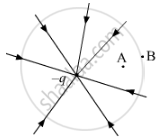Advertisements
Advertisements
प्रश्न
The bob of a simple pendulum has a mass of 40 g and a positive charge of 4.0 × 10−6 C. It makes 20 oscillations in 45 s. A vertical electric field pointing upward and of magnitude 2.5 × 104 NC−1 is switched on. How much time will it now take to complete 20 oscillations?
उत्तर
Given:
Charge of the particle, q = 4.0 × 10−6 C
Electrical field intensity, E = 2.5 × 104 NC−1
Mass of the particle, m = 40 g = 0.04 kg
When no electrical field is applied,
time period,
\[T_1 = 2\pi\sqrt{\frac{l}{g}}\]
When upward electrical field is applied,
time period,
\[T_2 = 2\pi\sqrt{\frac{l}{g - a}}\],
where a is the upward acceleration due to electrical field, which is given by
\[a = \frac{qE}{m}\]
\[ \Rightarrow a = \frac{4 \times {10}^{- 6} \times 2 . 5 \times {10}^4}{40 \times {10}^{- 3}}\]
\[ = 2 . 5 \text{m/ s}^2 \]
\[\therefore \frac{T_2}{T_1} = \sqrt{\frac{g}{g - a}}\]
\[ \Rightarrow \frac{T_2}{T_1} = \sqrt{\frac{9 . 8}{9 . 8 - 2 . 5}}\]
\[ \Rightarrow T_2 = 45 \times \sqrt{\frac{9 . 8}{7 . 3}} = 52 \] s
APPEARS IN
संबंधित प्रश्न
The field lines of a negative point charge are as shown in the figure. Does the kinetic energy of a small negative charge increase or decrease in going from B to A?

What is the function of uniform radial field and how is it produced?
Why must electrostatic field at the surface of a charged conductor be normal to the surface at every point? Give reason?
A charged oil drop weighing 1.6 x 10-15 N is found to remain suspended in a uniform electric field of intensity 2 x 103 Nc-1. Find the charge on the drop.
A hemisphere is uniformly charged positively. The electric field at a point on a diameter away from the centre is directed ______.
An electron falls from rest through a vertical distance h in a uniform and vertically upward directed electric field E. The direction of electric field is now reversed, keeping its magnitude the same. A proton is allowed to fall from rest in it through the same vertical distance h. The time of fall of the electron, in comparison to the time of fall of the proton is ______.
Assertion: On moving a distance two times the initial distance away from an infinitely long straight uniformly charged wire the electric field reduces to one-third of the initial value.
Reason: The electric field is inversely proportional to the distance from an infinitely long straight uniformly charged wire.
A particle of charge q and mass m moves rectilinearly under the action of electric field E = A – Bx, where A and B are positive constants and x is distance from the point where particle was initially at rest then the distance traveled by the particle before coming to rest and acceleration of particle at that moment are respectively.
Let there be a spherically symmetric charge distribution with charge density varying as `rho("r") = rho_0(5/4 - "r"/"R")` upto r = R, and `rho("r") = 0` for r > R, where r is the distance from the origin. The electric field at a distance r(r < R) from the origin is given by _________.
A charge Q is placed at the centre of the line joining two point charges +q and +q as shown in the figure. The ratio of charges Q and q is ______.

Electric field at a point varies as r° for ______.
Electric lines of force about negative point charge are ______
A charge of 4 × 10- 9c is distributed uniformly over the circumference of a conducting ring of radius 0.3 m. Calculate the field intensity at a point on the axis of the ring at 0.4 m from its center and also at the center?
Two equal point charges of the same sign are fixed on the y-axis, on either side of the origin equidistant from it, with the distance between them d. A third charge moves along the x-axis. The distance of the third charge from either of the two fixed charges when force on the third charge is maximum will be ______ cm.
[d = 10 cm]
In case of an infinite line charge, how does intensity of electric field at a point change, if at all, when.
- charge on it is doubled?
- distance of the point is halved?
